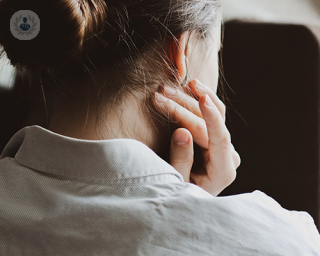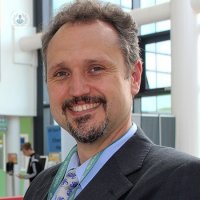Degenerative disc disease
Mr G Michael Hess - Orthopaedic surgery
Created on: 02-26-2013
Updated on: 06-08-2023
Edited by: Conor Lynch
What is degenerative disc disease?
We all have discs between the vertebrae, which, in young, healthy people, act as shock absorbers, helping the back to stay flexible and absorb the impact between the bones caused by movement. However, the natural ageing process leads to wear and tear, and the once rubbery discs shrink and lose integrity. This is known as degenerative disc disease (DDD).
Despite its name, degenerative disc disease is not a true disease, nor is it progressively degenerative. However, it can lead to low back pain (with or without sciatica), particularly if the discs collapse completely, leading to osteoarthritis.

What are the symptoms of degenerative disc disease?
Degenerative disc disease presents a series of localised symptoms, usually in the lower back or in the neck, depending on the location of the affected discs. Symptoms include:
- Pain that can range from mild and nagging to persistent and disabling
- Pain in the lower part of the back, which radiates towards the buttocks and thighs
- Pain in the neck that radiates to the arms and hands
- Pain that gets worse when sitting
- Pain when bending, getting up or twisting the body
- Pain that is relieved when walking and moving
- Pain that decreases if you change position often
- Severe intermittent pain, lasting from a few days to months
- Tingling and numbness in extremities
- Muscle weakness in the legs and feet
What are the causes of degenerative disc disease?
There are several factors that cause degenerative disc disease, mostly associated with natural wear and tear over time:
- Ageing
- Dry discs – as we age the spinal discs dry out, meaning they are less capable of absorbing shock.
- Activity, exercise and sports – over time, activity can lead to tears in the outer core of the discs.
- Injuries
What is the treatment for degenerative disc disease?
The main objective of treatment is to manage the pain. To this end, it is necessary to exercise to increase the strength and flexibility of the muscles that surround the spine. Exercise increases blood circulation to the back, providing the joints and muscles with oxygen and nutrients, and carrying inflammatory waste products away.
In addition, there are treatments that promote the strengthening of the back:
- Physical therapy
- Medications, including non-steroidal anti-inflammatories (NSAIDs) and pain relievers (consult your doctor about what medications you should take, if any).
- Surgery – this may involve replacement of the discs with artificial implants or spinal fusion
- Spinal mobilisation
- Applying heat and cold to the painful area

















